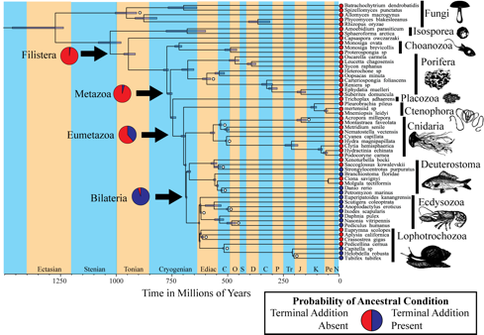2014 Annual Science Report
 Massachusetts Institute of Technology
Reporting | SEP 2013 – DEC 2014
Massachusetts Institute of Technology
Reporting | SEP 2013 – DEC 2014
Early Animals: Modeling the Biotic-Abiotic Interface in the Early Evolution of Multicellular Form
Project Summary
The size of early multicellular organisms was sufficint to modify their local environment. Our initial work modeling of Neoproterozoic frond-like forms in the earliest-known communities of multicellular organisms demonstrates they were of sufficient scale and density to generate a distinctive canopy flow-regime. This modified environment yielded a selective advantage towards large eukaryotic forms that evolved at this time. This result is a function of limits imposed by diffusion at the surface of organisms, and how height and attendant velocity exposure escape these limits. Building on these results, we are now developing additional models of abiotic/biotic interactions at organismal surfaces, which are implicit in the morphology, development and orientation of other Neoproterozoic fossils. Ultimately, this work will help illuminate how forms initialy dependent on passive diffusion became more trophically complex, yielding a transition to the animal radiation.
Project Progress
Our initial work effectively addressed the advantage of size in the earliest know communities of large multicellular organisms, found at Mistaken point in Newfoundland. We found that nutrient uptake rates are strongly controlled by fluid velocity in the low-velocity regimes characteristic of these deep-water environments, and that canopy flow models generated a velocity gradient that extended far above the bottom. Consequently, there was a strong advantage to increase exposure to flow through growth higher height above the sea floor. These heights could only be achieved by multicellular eukaryotic architecture—explaining the advantage of eukaryotic size in the late Precambrian at the dawn of animal life.
Our initial work on this (Ghisalberti et al. 2014) was published in Current Biology along with a companion piece (Xiao 2014) and video abstract. This publication has been widely cited in the popular and scientific press (see links below).
We are now extending this research through additional modeling of surface biotic/abiotic processes relevant to the early evolution of complex life. In particular Jacobs, with Ghisalberti and Treude, are developing new models for processes occurring across epithelia placed at the sediment-water interface. These models are initially intended to speak to the processes going on in flatlying ediacaran forms such as Dickinsonia. As part of this project, we have developed an ancestral state reconstruction model linking the development process observed in Dickinsonia with the terminal addition process thought to be ancestral in Bilateria; this work has been presented at an international meeting and is in review (see Fig. 1). We anticipate that biotic epithelial, when placed in contact with the sediment surface, will modify redox gradients due to differences in permeability, and transport properties of biotic surface relative to the underlying sediment. This may lead to a more general epithelium uptake-based model for the evolution of early multicellular form, where epethilia provide partitions critical to modifying the environment to augment processes at the bioticabiotic interface to the nutritional benefit of the organism. We anticipate that this combined approach—where environment and epithelia are modeled in concert—will illuminate aspects of the early evolution of multicellular form.
Links to coverage in the popular press:
http://newsroom.ucla.edu/releases/scientists-reveal-why-life-got-249899 http://marinesciencetoday.com/2014/01/28/why-did-life-in-the-oceans-get-so-big/
Canopy Flow Analysis Reveals http://www.sciencedaily.com/releases/2014/01/140123125536.htm
http://article.wn.com/view/2014/01/24/Scientists_reveal_why_life_got_big_in_the_Earths_early_ocean/
http://www.ineffableisland.com/2014/01/why-life-got-big-in-earths-early-oceans.html
http://scitechdaily.com/study-reveals-life-earths-early-oceans-increased-size/
http://www.yourepeat.com/watch/?v=MwM1bMmPn7g
http://www.thodan.net/watch/MwM1bMmPn7g.html
http://player.mashpedia.com/player.php?q=MwM1bMmPn7g
http://paleonews.ru/index.php/new/288-ediacarian
http://360available.blogspot.com/2014_02_01_archive.html
http://www.mydailynewswatchng.com/life-early-oceans-increased-size/?wpmp_switcher=mobile&wpmp_tp=0
http://www.rdmag.com/news/2014/01/scientists-reveal-why-life-got-big-earth%E2%80%99s-early-oceans
http://techlately.com/study-reveals-why-life-in-earths-early-oceans-increased-in-size/
https://phenomenalistempiricism.wordpress.com/2014/02/page/3/
voxhumana-english.com/Newest%20Science%20News%20Blog%20201
voxhumana-english.com/Newest%20Science%20News%20Blog%20201
Publications
-
Ghisalberti, M., Gold, D. A., Laflamme, M., Clapham, M. E., Narbonne, G. M., Summons, R. E., … Jacobs, D. K. (2014). Canopy Flow Analysis Reveals the Advantage of Size in the Oldest Communities of Multicellular Eukaryotes. Current Biology, 24(3), 305–309. doi:10.1016/j.cub.2013.12.017
-
PROJECT INVESTIGATORS:
-
PROJECT MEMBERS:
David Jacobs
Project Investigator
Marco Ghisalberti
Co-Investigator
David Gold
Co-Investigator
David Johnston
Co-Investigator
Marc LaFlamme
Co-Investigator
Roger Summons
Co-Investigator
Tina Treude
Collaborator
-
RELATED OBJECTIVES:
Objective 4.1
Earth's early biosphere.
Objective 4.2
Production of complex life.
Objective 5.2
Co-evolution of microbial communities
Objective 6.1
Effects of environmental changes on microbial ecosystems
